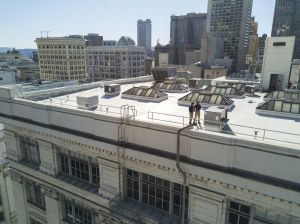Presented By: Partner Insights
COVID-19: A Modernization Wake-Up Call for CRE Owners
By Partner Insights July 14, 2020 1:01 pm
reprints
Running a cost-efficient building is enough of a challenge on its own without a global pandemic making it unsafe for employees to come to work. Now, as business begins to revive in some areas, building owners face the increasing challenge of keeping costs down while meeting new and evolving health standards and social distancing requirements in the workplace.
Carbon Lighthouse is an Energy Savings-as-a-Service company that uses AI technology to design profitable climate solutions for CRE that cut carbon emissions while driving value to ownership’s bottom line. On Wednesday, June 24, Commercial Observer’s Partner Insights team hosted a webinar presented by Carbon Lighthouse titled, “Future-Proofing Your Portfolio: COVID-era CRE Strategies.”
Matt Ganser, the company’s EVP of Engineering and Technology, moderated the discussion, joined by panelists Eric R. Smith, EVP of Business Development with L&B Realty Advisors, LLP, and Deborah Boyer, EVP, Director of Innovation and Community Impact, The Swig Company.
The panel began by addressing solutions they implemented early in the COVID crisis. Smith discussed the realization, as information evolved, that the most pertinent factors for COVID transmission included “high density environments, close proximity duration to the affected persons, asymptomatic or presymptomatic transmission up to five days, and enclosed spaces with poor ventilation.”
“So the first goal is to communicate to our tenants that the first four of the primary risk factors are for individuals to control, not the building. We need to understand that,” he said. “We need to communicate that to our tenants so they communicate it to their employees and their guests. We think that’s a big responsibility.”
He then cited a framework outlined by NIOSH, the National Institute for Occupational Safety and Health, that provided feasible control solutions to protect workers from illness and injury.
“We think that’s the applicable framework to use,” he said. “It’s a pyramid from most effective to least effective, and it goes, elimination, substitution, engineering controls, administrative controls, and PPE, with PPE being least effective. So we said, how does this hierarchy relate to the current situation. Elimination is keeping sick people out of the building.”
His company applied substitution in this case to “keeping physical distance and wearing a face covering,” and engineering controls to strengthening areas such as poorly ventilated elevator cabs or restrooms.
“We’ve timed all of our elevator rides and all of our buildings,” he said, adding that they also upgraded all their exhaust fans. “You’re only on the elevator for two minutes, and the exhaust rate is 400 CFM (cubic feet per minute), which means it’s exhausting the air out of that elevator cab 60 times an hour. So that gives us a level of comfort.”
Boyer then walked through some of the changes in her buildings on the tenant side.
“A lot of the things we’re implementing are really operational controls. The lion’s share of what we’re doing now is trying to set things up for an as-safe-as-possible return, including working with tenants on understanding their schedules and encouraging them to stagger their employee start times to help ease bottlenecks into the building,” she said. “We created a whole new set of building rules and regulations related to COVID-19 that included a lot of information for our tenants, and links to resources to help them understand what is required in their office space and what reporting they need to do to the landlord.”

Ganser asked about the delicate juggling act that is trying to collect rent and understanding when deferment or relief are simply the right things to do.
“If your employees are too scared to come into your office building, that’s not a good situation to fight without having done a significant amount of work on the front end. So we’re doing that work. We don’t want to be the cause of why they’re scared to come to the office,” said Smith. “We want to give the tenant all the information about what we’re doing so that they can educate their employees and guests. You’ve got to be in partnership with your tenants. You’ve got to realize this is a people problem, not necessarily a contractual problem.”
Ganser then asked if they anticipate cost increases.
Smith said he does, with electricity costs related to preventing heating, ventilating, and A/C systems from spreading the disease potentially rising 1.5-3 times over the normal cost. Adding chronic cleaning and disinfection costs bumps them even higher, he said.
Boyer added that she’s factoring in increased labor costs in addition to increased cleaning costs and PPE. But she did add that she’s not overly concerned about runaway costs.
“I don’t know that we’re going to see significant cost increases in the future,” she said. “I am optimistic, because we already run our buildings pretty responsibly.”
Looking forward in a broader sense, Smith called this time a “wake-up call for modernization,” because “more and more, [tenants are] going to be interviewing buildings based on indoor air quality.” The challenge for owners, then, will be maximizing air quality while controlling costs.
Boyer believes that our current moment will inspire innovation in this area, making office environments healthier overall.
“There’s going to be a lot of technological development coming from what’s happening now,” said Boyer. “There’s going to be a need to control costs and control the environmental services we’re providing without that translating to increased operating costs. So I do think there’s going to be plenty of pressure on us to make those kinds of modernizations – to adapt.”
Summing up, while the post-COVID era has potential to spur innovation, Boyer said she believes we’ll see less radical change than an expansion of already growing trends.
“I think the demand for flex office is here to stay, and will grow,” she said. “We’ll see a continued demand for shorter lease terms and space that’s immediately available on a turnkey, plug and play basis. We’re certainly seeing de-densification right now, more square footage per person in the short term, but I think we’ll continue to see that in the longer term because the pendulum had already swung away from really close layouts. And we’ll see changes around occupancy tracking and touchless access and sensor technology – virtual tools, and things like that.”
To view the full “Future-Proofing Your Portfolio: COVID-era CRE Strategies” webinar, click here.



